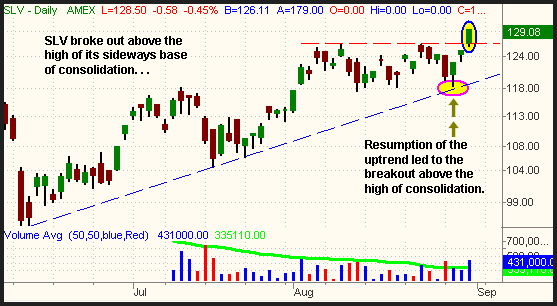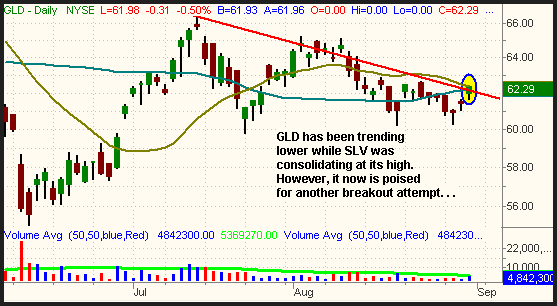The major indices wrapped up the month of August with a relatively flat session, but higher volume hinted at a bit of selling into strength. Both the S&P 500 and Dow Jones Industrial Average edged less than 0.1% lower, while the Nasdaq Composite snapped its five-day winning streak by losing 0.1%. The small-cap Russell 2000 was unchanged, but the S&P Midcap 400 woke up and rallied 0.4%. Stocks attempted to break out in the final ninety minutes of trading, but the attempt failed, sending the broad market back down to finish where it spent the first half of the day. The S&P, Nasdaq, and Dow all finished in the bottom third of their intraday ranges, though the Nasdaq showed the most relative weakness.
Total volume in the both the NYSE and Nasdaq was 4% higher than the previous day's levels. Although the major indices finished nearly unchanged, it was actually bearish that turnover increased. When consolidating at the top of a range, you want to see decreasing volume because it indicates the bears are not stepping in while the buyers are taking a rest. However, if near the high of a range, increasing volume occurs without corresponding gains often points to traders selling into the strength of a rally attempt. This is known as "churning" and should serve as a warning sign that a short-term top may be forming. We liken "churning" to a sports car that attempts to accelerate too fast. Rather than shooting down the highway, it will merely spin its wheels in place. Conversely, the opposite volume pattern is effective at predicting short-term bottoms. If, at the low of a range, you see increasing volume without further price losses, it indicates traders are buying into weakness and accumulating shares of stock. Remember that volume is the one technical indicator that never lies and is the most accurate leading technical indicator at your disposal.
Shortly after yesterday's open, we sent an intraday e-mail alert to regular subscribers, informing them that the iShares Silver Trust (SLV) had broken out above of a range of bullish consolidation and that it looked good for a potential purchase. It subsequently gained two more points throughout the remainder of the session and looks good for further upside in the coming days to weeks. As you might recall, we initially bought SLV when it first broke out above its 50-day moving average on August 1. SLV subsequently hit our trailing stop price on August 11, netting us a gain of more than 2.5 points on the trade. Because we suspected that it may have been a "shakeout," we continued monitoring the price action of SLV in the weeks that followed. It has acted well since then, consolidating in a relatively tight range near its highs. That bullish consolidation has built a solid base of support, which is the reason we told subscribers about yesterday morning's breakout above the range. The daily chart of SLV illustrates the clear breakout above the range:

Since we've been discussing the bullish pattern in silver, you may be wondering why we did not buy gold instead. The answer is simply that gold has been showing much more relative weakness than silver. The StreetTRACKS Gold Trust (GLD), which mirrors the price of the spot gold commodity, technically remains in an intermediate-term downtrend that has been in place since the middle of May. While SLV was consolidating in a narrow, sideways range throughout the month of August, GLD was drifting lower. Obviously, we always want to buy the sector ETFs that exhibit the most relative strength, NOT those that are lagging behind. Nevertheless, GLD gained 1.4% yesterday and closed just above its 50-day moving average. It also finished right at resistance of its multi-month downtrend line:

If you compare the charts of GLD and SLV, you will should easily notice the divergence and relative strength of SLV over GLD. However, that being said, it appears that GLD will now attempt to break out above its downtrend line as well. If it clears yesterday's high, it would not be a bad idea to take a shot at buying shares of GLD, but the corresponding gains in SLV are likely to outpace those of GLD. Notice also that GLD briefly broke out above its downtrend line in early August, but failed to hold the breakout. One must therefore be on alert for a possible repeat of the same scenario.
Deron Wagner is the Founder and Head Trader of both Morpheus Capital LP, a U.S. hedge fund, and Morpheus Trading Group, a trader education firm launched in 2001 that provides daily technical analysis of the leading ETFs and stocks. For a free trial to the full version of The Wagner Daily or to learn about Wagner's other services, visit MorpheusTrading.com or send an e-mail to deron@morpheustrading.com.